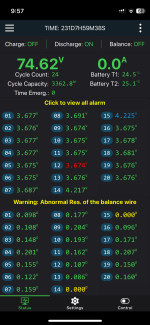brownj24
1 mW
- Joined
- Aug 22, 2020
- Messages
- 19
Hello,
I built at 21s34p battery for my Bullitt cargo bike front bay area. Yeah, it's big!
Sadly, after only 24 cycles, my chargers were shut off by the BMS with the following error (see pic). 2 of the 21 strings show a little over 4.2v full charge, but all the other cells stayed around 3.7. The BMS also shows 0 wire (nickel strip) resistance on those two cell groups that charged up to 4.2v.
Prior to this, I did notice a hot spot on the battery pack beginning to melt through the blue shrink wrap (even while temperature probes showed overall battery temperature within spec for the EVE 21700 lithium cells used).
I'm looking for your advice/help if you can offer any suggestions as to likely cause of failure and what you would check first.
My plan: Check BMS connections and BMS wire connections, Check spot welds on the hot spot area on those two cell groups that are charged to 4.2v right now. Maybe try to bleed them down closer to the other cell groups if indeed the nickel strip welds have failed somewhere.
I'd appreciate any suggestions. Thanks!
Jeremiah
PS. Here's a video of me building the battery in case you're curious:
I built at 21s34p battery for my Bullitt cargo bike front bay area. Yeah, it's big!
Sadly, after only 24 cycles, my chargers were shut off by the BMS with the following error (see pic). 2 of the 21 strings show a little over 4.2v full charge, but all the other cells stayed around 3.7. The BMS also shows 0 wire (nickel strip) resistance on those two cell groups that charged up to 4.2v.
Prior to this, I did notice a hot spot on the battery pack beginning to melt through the blue shrink wrap (even while temperature probes showed overall battery temperature within spec for the EVE 21700 lithium cells used).
I'm looking for your advice/help if you can offer any suggestions as to likely cause of failure and what you would check first.
My plan: Check BMS connections and BMS wire connections, Check spot welds on the hot spot area on those two cell groups that are charged to 4.2v right now. Maybe try to bleed them down closer to the other cell groups if indeed the nickel strip welds have failed somewhere.
I'd appreciate any suggestions. Thanks!
Jeremiah
PS. Here's a video of me building the battery in case you're curious:


